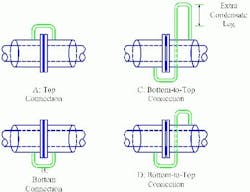Make jacketing your strong suit
Utility systems are just as important as process systems for overall plant success. So, they deserve the same attention to detail and review that process systems demand. Unfortunately, however, utility systems too often get short shrift.
Consider jacketed piping which is manufactured in relatively short, flanged sections, typically 20 ft long. These short sections allow for isolation of segments of the pipe, to identify the specific location where a leak between the process fluid and the heating medium may be occurring, and enable reasonably quick replacement of a damaged section.
If steam is the heating medium, it’s unusual for each piping segment to have its own steam and condensate connection. Instead, a jump-over on the jacket side connects the heating utility from one section to another and allows both steam and condensate to flow downstream to the next section.
This jump-over connection is one detail that’s easily overlooked. Yet, mistakes can prove costly. In one case, inappropriate connections resulted in a sulfur line setting solid, despite the use of 50-psig (268°F) steam, well above the temperature at which sulfur solidifies (238°F). The pressure drop on the steam side of the jacketed piping reduced the actual steam pressure available to below 5 psig (228°F).
Figure 1 shows four different connection configurations. Configuration D most commonly appears in engineering standards. Configuration B works just as well, if not better. Configurations A and C both can bring significant problems.
Figure 1. Four different connection configurations are illustrated.
Condensate, of course, accumulates in the bottom of the jacket. Therefore, if the jump-over is at the top (Configuration A), then the jacket fills up with condensate, which has a much lower heat-transfer coefficient than condensing steam. Many applications will completely fail if the pipe fills with condensate.
Additionally, the condensate increases the pressure drop through the system. Steam pressure decreases dramatically toward the last pipe segment before the condensate return. At lower pressure, the condensate may not be able to enter the condensate return system or the steam may no longer be hot enough to meet process conditions.
Configurations C and D both take the steam and condensate mixture from the bottom and send it to the top of the next pipe. In the rising part of the jump-over, the two-phase mixture creates a static head. Downstream pressure may be lower than expected. As long as the pressure drops through the jacketing system are understood and have been allowed for, Configuration D works well.
However, the steam connections from one segment to another are rarely engineered to the same level as process systems. Often, these connections are left to field installers to fit. If the jump-over goes too high (as shown in Configuration C), the extra height increases the pressure drop through the system. This may not seem like much in a single jump-over, but five, 10 or 20 jump-overs like this in a row can have a big impact.
Configuration B, while less common, takes the steam and condensate mixture from the bottom of the pipe and returns it to the bottom of the next section. This works well and has few problems.

